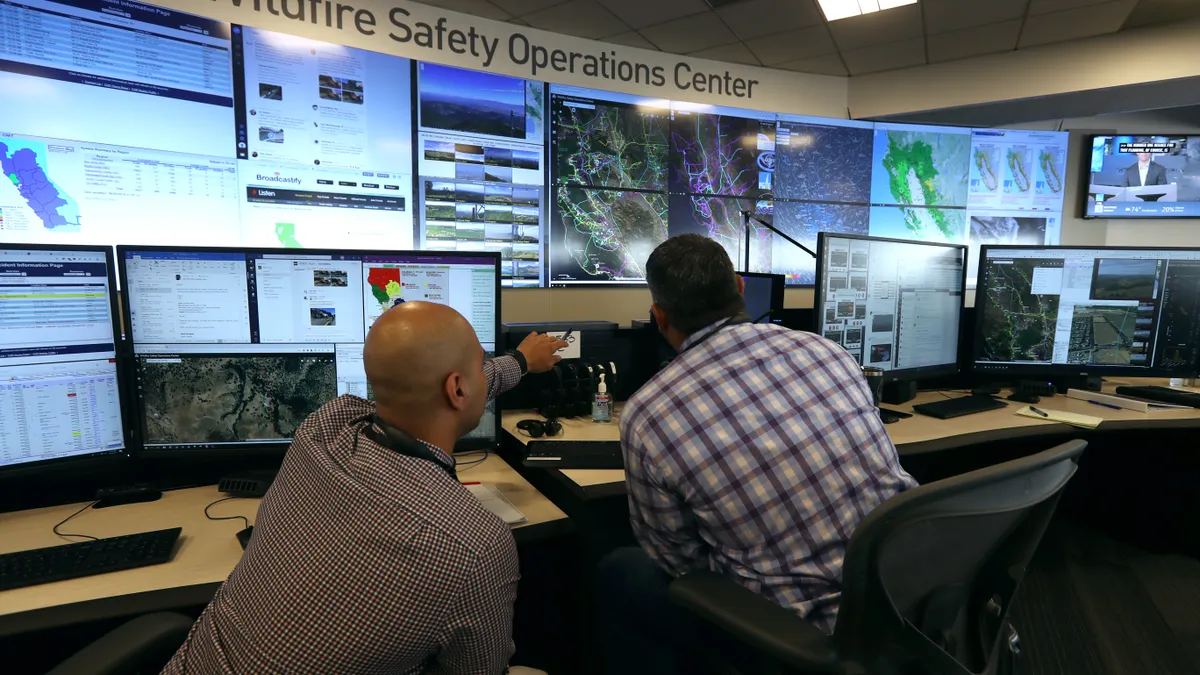Dive Brief:
- California regulators this week released a proposed decision finding the state's three investor-owned utilities, Pacific Gas & Electric (PG&E), Southern California Edison (SCE) and San Diego Gas & Electric (SDG&E), failed to comply with regulatory guidelines when deploying a series of wildfire-related power shut-offs in 2019.
- If approved, the California Public Utilities Commission's (CPUC) proposal would impose a suite of remedies on the utilities. This includes preventing revenue collection tied to electricity that utilities don't sell during shutoffs for the time being.
- The three utilities collectively shut off power to more than 2.1 million households, businesses and other customer accounts in late 2019. While they have maintained that these shut-offs help prevent wildfires in California, regulators have grown increasingly concerned about the impact on customers.
Dive Insight:
The CPUC opened a formal investigation into utility shutoffs in November 2019, after all three utilities de-energized their lines "to a degree not seen in the past," as the proposal notes. Utility-caused wildfires have been an ongoing threat in California over the last several years, and pushed the state's largest utility, PG&E, into bankruptcy in early 2019.
Regulators are worried about how the shut-offs impact communities, especially medically vulnerable customers; in 2019, nearly 77,000 customer accounts that had their power turned off depended on electricity for their medical needs. But state utilities have pointed out that the shut-offs do reduce the risk of wildfires. During a prolonged shut-off that began on Oct. 26, 2019, for instance, PG&E found 328 instances of damage to its powerlines, the utility reported.
While the commission acknowledges utilities may sometimes need to turn off the power as a last resort, "power shutoffs create major disruptions for the public, an entirely separate set of safety concerns, and, essentially, result in an emergency situation," the proposal states. Regulators have concluded in the proposed decision that all three utilities failed to reasonably comply with regulatory guidelines and "the obligation to promote safety" in how they deployed the shut-offs.
Regulators have identified multiple gaps in the utility's execution of the shut-offs. PG&E, for instance, experienced communication network outages, did not adequately coordinate back-up power, and didn't do a good enough job of coordinating with local jurisdictions regarding the shut-offs, according to the CPUC. SCE, meanwhile, presented "illegible maps" representing the zones that it shut off power to, and didn't communicate information to customers in languages other than English, the commission said — and in SDG&E's case, not enough information was provided on how its notification strategies incorporated geographic and cultural demographics.
In addition to foregoing some revenue, the CPUC's proposal would instruct utilities to take multiple measures to improve communications with customers that are reliant on electricity for medical needs like life support, provide emergency management system training to their personnel and contractors, and file annual reports updating the commission on the improvements they are implementing.
Commissioners are scheduled to vote on the proposed decision at an agency meeting on May 20.
SCE is looking at the proposed decision and will have further comment once it's had an opportunity to more fully review it, utility spokesperson Robert Laffoon-Villegas said.
"[Public safety power shut-offs] are a measure of last resort, used only when needed to keep communities safe and as outlined in our PSPS action plan, we are taking steps to reduce the frequency of shut-offs and minimize the number of impacted customers," Laffoon-Villegas added.
"Following the PSPS events in 2019, we recognized that we needed to make significant improvements to better serve our customers. That is why, in 2020, we focused on reducing the size and length of PSPS events and providing better resources before, during and after," PG&E spokesperson Lynsey Paulo said in an email.
Improvements included opening 245 community resource centers and providing 6,500 portable batteries to low-income customers and those with medical needs, Paulo added.
"We are currently reviewing the proposed decision as put forth by the CPUC and we intend to present comments by the May 10 due date," said SDG&E spokesperson Denice Menard in an email.















